SKODA ROOMSTER 2010 1.G Owner's Manual
Manufacturer: SKODA, Model Year: 2010, Model line: ROOMSTER, Model: SKODA ROOMSTER 2010 1.GPages: 231, PDF Size: 12.91 MB
Page 171 of 231
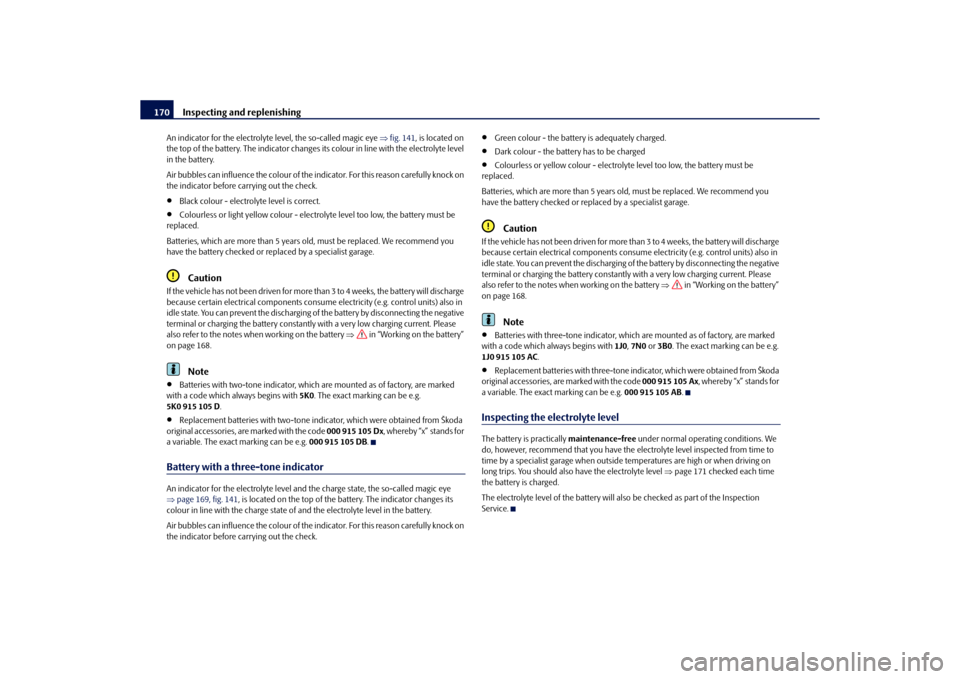
Inspecting and replenishing
170
An indicator for the electrolyte level, the so-called magic eye fig. 141 , is located on
the top of the battery. The indicator changes it s colour in line with the electrolyte level
in the battery.
Air bubbles can influence the colour of the in dicator. For this reason carefully knock on
the indicator before carrying out the check.
Black colour - electrolyte level is correct.
Colourless or light yellow colour - electrolyte level too low, the battery must be
replaced.
Batteries, which are more than 5 years old, must be replaced. We recommend you
have the battery checked or replaced by a specialist garage.Caution
If the vehicle has not been driven for more than 3 to 4 weeks, the battery will discharge
because certain electrical components consum e electricity (e.g. control units) also in
idle state. You can prevent the discharging of the battery by disconnecting the negative
terminal or charging the battery constantly with a very low charging current. Please
also refer to the notes wh en working on the battery in “Working on the battery”
on page 168.
Note
Batteries with two-tone indicator, which are mounted as of factory, are marked
with a code which always begins with 5K0. The exact marking can be e.g.
5K0 915 105 D .
Replacement batteries with two-tone indi cator, which were obtained from Škoda
original accessories, are marked with the code 000 915 105 Dx, whereby “x” stands for
a variable. The exact marking can be e.g. 000 915 105 DB.
Battery with a three-tone indicatorAn indicator for the electrolyte level and the charge state, the so-called magic eye
page 169, fig. 141 , is located on the top of the ba ttery. The indicator changes its
colour in line with the charge state of and the electrolyte level in the battery.
Air bubbles can influence the colour of the in dicator. For this reason carefully knock on
the indicator before carrying out the check.
Green colour - the battery is adequately charged.
Dark colour - the battery has to be charged
Colourless or yellow colour - electrolyte level too low, the battery must be
replaced.
Batteries, which are more than 5 years old, must be replaced. We recommend you
have the battery checked or replaced by a specialist garage.Caution
If the vehicle has not been driven for more than 3 to 4 weeks, the battery will discharge
because certain electrical components consume electricity (e .g. control units) also in
idle state. You can prevent the discharging of the battery by disconnecting the negative
terminal or charging the battery constantly with a very low charging current. Please
also refer to the notes when working on the battery in “Working on the battery”
on page 168.
Note
Batteries with three-tone indicator, which are mounted as of factory, are marked
with a code which always begins with 1J0, 7N0 or 3B0 . The exact marking can be e.g.
1J0 915 105 AC .
Replacement batteries with three-tone indi cator, which were obtained from Škoda
original accessories, are marked with the code 000 915 105 Ax, whereby “x” stands for
a variable. The exact marking can be e.g. 000 915 105 AB.
Inspecting the electrolyte levelThe battery is practically maintenance-free under normal operating conditions. We
do, however, recommend that you have the electrolyte level inspected from time to
time by a specialist garage when outside temperatures are high or when driving on
long trips. You should also have the electrolyte level page 171 checked each time
the battery is charged.
The electrolyte level of the battery will al so be checked as part of the Inspection
Service.
s16g.4.book Page 170 Wednesda y, February 10, 2010 3:53 PM
Page 172 of 231
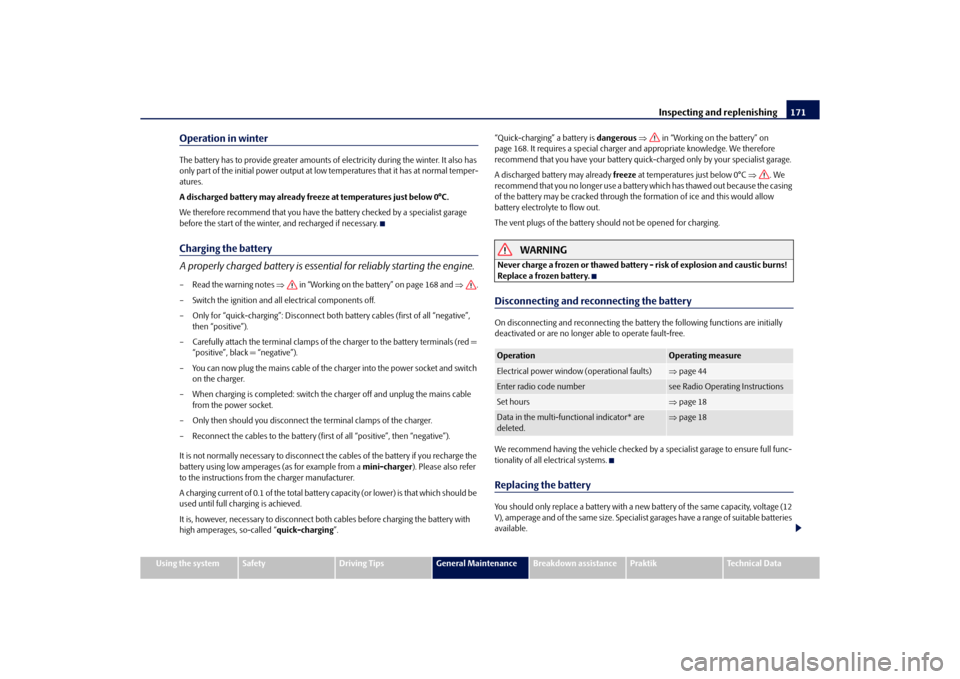
Inspecting and replenishing171
Using the system
Safety
Driving Tips
General Maintenance
Breakdown assistance
Praktik
Technical Data
Operation in winterThe battery has to provide greater amounts of electricity during the winter. It also has
only part of the initial power output at low temperatures that it has at normal temper-
atures.
A discharged battery may already freez e at temperatures just below 0°C.
We therefore recommend that you have the battery checked by a specialist garage
before the start of the winter, and recharged if necessary.Charging the battery
A properly charged battery is essentia l for reliably starting the engine.– Read the warning notes in “Working on the battery” on page 168 and .
– Switch the ignition and all electrical components off.
– Only for “quick-charging”: Disconnect both battery cables (first of all “negative”,
then “positive”).
– Carefully attach the terminal clamps of the charger to the battery terminals (red = “positive”, black = “negative”).
– You can now plug the mains cable of the charger into the power socket and switch
on the charger.
– When charging is completed: switch th e charger off and unplug the mains cable
from the power socket.
– Only then should you disconnect the terminal clamps of the charger.
– Reconnect the cables to the battery (first of all “positive”, then “negative”).
It is not normally necessary to disconnect th e cables of the battery if you recharge the
battery using low amperages (as for example from a mini-charger ). Please also refer
to the instructions from the charger manufacturer.
A charging current of 0.1 of the total battery capacity (or lower) is that which should be
used until full charging is achieved.
It is, however, necessary to disconnect both cables before charging the battery with
high amperages, so-called “ quick-charging”. “Quick-charging” a battery is
dangerous in “Working on the battery” on
page 168. It requires a special charger an d appropriate knowledge. We therefore
recommend that you have your battery quick- charged only by your specialist garage.
A discharged battery may already freeze at temperatures just below 0°C . We
recommend that you no longer use a battery which has thawed out because the casing
of the battery may be cracked through the formation of ice and this would allow
battery electrolyte to flow out.
The vent plugs of the battery should not be opened for charging.
WARNING
Never charge a frozen or thawed battery - risk of explosion and caustic burns!
Replace a frozen battery.Disconnecting and reconnecting the batteryOn disconnecting and reconnecting the battery the following functions are initially
deactivated or are no longer able to operate fault-free.
We recommend having the vehicle checked by a specialist garage to ensure full func-
tionality of all electrical systems.Replacing the batteryYou should only replace a battery with a ne w battery of the same capacity, voltage (12
V), amperage and of the same size. Specialist garages have a range of suitable batteries
available.Operation
Operating measure
Electrical power window (operational faults)
page 44
Enter radio code number
see Radio Operating Instructions
Set hours
page 18
Data in the multi-functional indicator* are
deleted.
page 18
s16g.4.book Page 171 Wednesda y, February 10, 2010 3:53 PM
Page 173 of 231
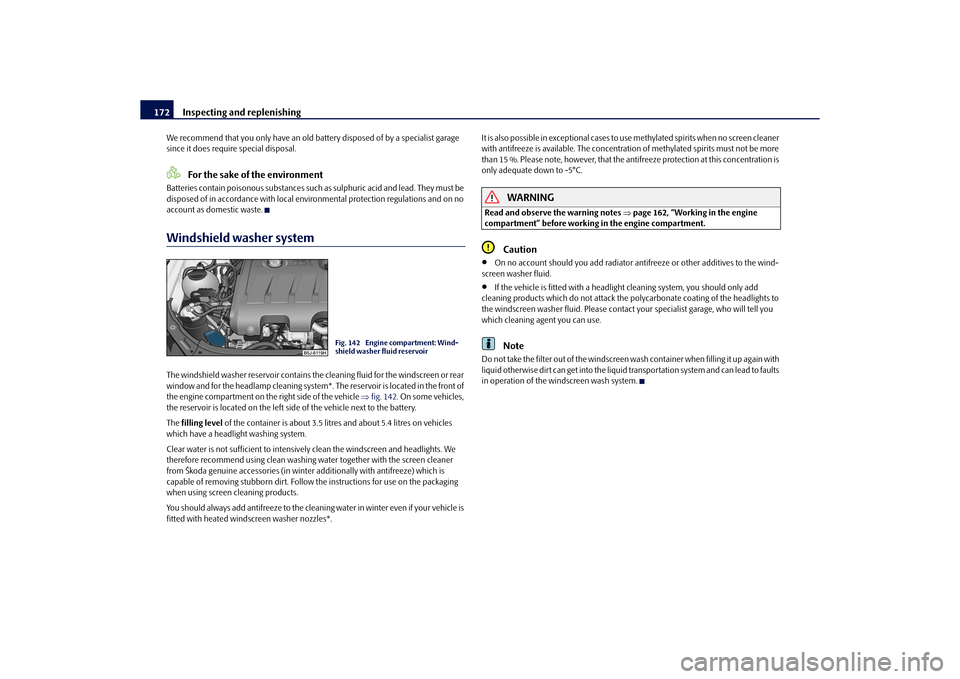
Inspecting and replenishing
172
We recommend that you only have an old ba ttery disposed of by a specialist garage
since it does require special disposal.
For the sake of the environment
Batteries contain poisonous substances such as sulphuric acid and lead. They must be
disposed of in accordance with local environmental protection regulations and on no
account as domestic waste.Windshield washer systemThe windshield washer reservoir contains the cleaning fluid for the windscreen or rear
window and for the headlamp cl eaning system*. The reservoir is located in the front of
the engine compartment on the right side of the vehicle fig. 142 . On some vehicles,
the reservoir is located on the left side of the vehicle next to the battery.
The filling level of the container is about 3.5 litres and about 5.4 litres on vehicles
which have a headlight washing system.
Clear water is not sufficient to intensively clean the windscreen and headlights. We
therefore recommend using clean washing water together with the screen cleaner
from Škoda genuine accessories (in winter additionally with antifreeze) which is
capable of removing stubborn dirt. Follow the instructions for use on the packaging
when using screen cleaning products.
You should always add antifreeze to the cleani ng water in winter even if your vehicle is
fitted with heated wind screen washer nozzles*. It is also possible in exceptional cases to use methylated spirits when no screen cleaner
with antifreeze is available. The concentration of methylated spirits must not be more
than 15 %. Please note, however, that the anti
freeze protection at this concentration is
only adequate down to -5°C.
WARNING
Read and observe the warning notes page 162, “Working in the engine
compartment” before working in the engine compartment.
Caution
On no account should you add radiator an tifreeze or other additives to the wind-
screen washer fluid.
If the vehicle is fitted wi th a headlight cleaning system, you should only add
cleaning products which do not attack the polycarbonate coating of the headlights to
the windscreen washer fluid. Please contac t your specialist garage, who will tell you
which cleaning agent you can use.Note
Do not take the filter out of the windscreen wash container when filling it up again with
liquid otherwise dirt can get into the liquid transportation system and can lead to faults
in operation of the windscreen wash system.
Fig. 142 Engine compartment: Wind-
shield washer fluid reservoir
s16g.4.book Page 172 Wednesda y, February 10, 2010 3:53 PM
Page 174 of 231
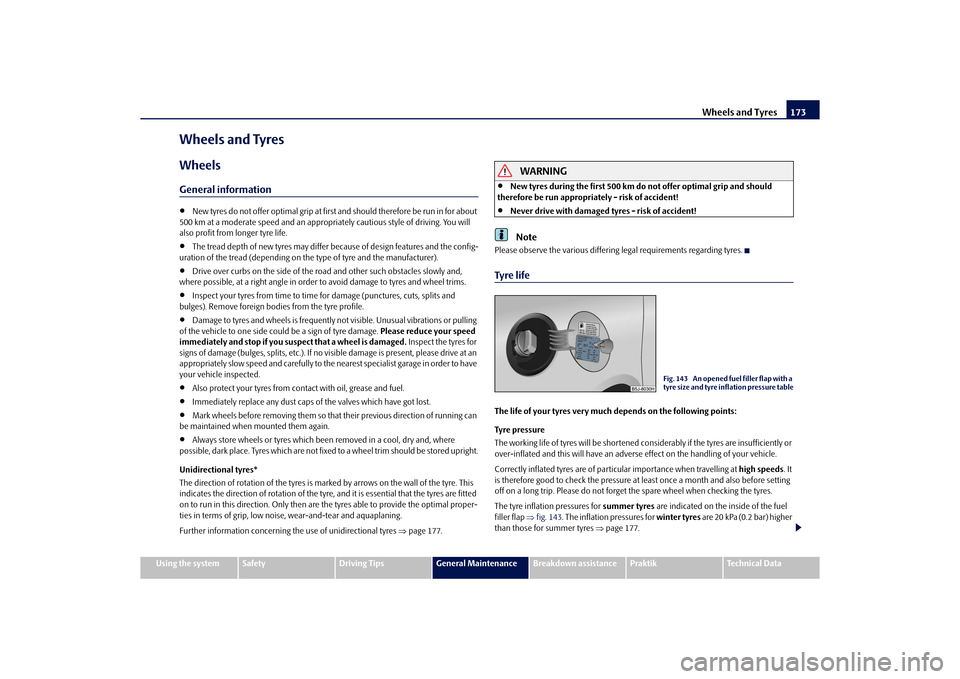
Wheels and Tyres173
Using the system
Safety
Driving Tips
General Maintenance
Breakdown assistance
Praktik
Technical Data
Wheels and TyresWheelsGeneral information
New tyres do not offer optimal grip at first and should therefore be run in for about
500 km at a moderate speed and an appropri ately cautious style of driving. You will
also profit from longer tyre life.
The tread depth of new tyres may differ because of design features and the config-
uration of the tread (depending on the type of tyre and the manufacturer).
Drive over curbs on the side of the road and other such obstacles slowly and,
where possible, at a right angle in order to avoid damage to tyres and wheel trims.
Inspect your tyres from time to time for damage (punctures, cuts, splits and
bulges). Remove foreign bodies from the tyre profile.
Damage to tyres and wheels is frequently not visible. Unusual vi brations or pulling
of the vehicle to one side coul d be a sign of tyre damage. Please reduce your speed
immediately and stop if you su spect that a wheel is damaged. Inspect the tyres for
signs of damage (bulges, splits, etc.). If no visible damage is present, please drive at an
appropriately slow speed and carefully to the nearest specialist garage in order to have
your vehicle inspected.
Also protect your tyres from contact with oil, grease and fuel.
Immediately replace any dust caps of the valves which have got lost.
Mark wheels before removing them so that their previous direction of running can
be maintained when mounted them again.
Always store wheels or tyres which been removed in a cool, dry and, where
possible, dark place. Tyres which are not fixed to a wheel trim should be stored upright.
Unidirectional tyres*
The direction of rotation of the tyres is mark ed by arrows on the wall of the tyre. This
indicates the direction of rotation of the tyre, and it is essential that the tyres are fitted
on to run in this direction. Only then are the tyres able to provide the optimal proper-
ties in terms of grip, low nois e, wear-and-tear and aquaplaning.
Further information concerning th e use of unidirectional tyres page 177.
WARNING
New tyres during the first 500 km do not offer optimal grip and should
therefore be run appropriately - risk of accident!
Never drive with damaged tyres - risk of accident!Note
Please observe the various differing legal requirements regarding tyres.Ty re l i feThe life of your tyres very much depends on the following points:
Tyre pressure
The working life of tyres will be shortened considerably if the tyres are insufficiently or
over-inflated and this will have an adverse effect on the handling of your vehicle.
Correctly inflated tyres are of particular importance when travelling at high speeds. It
is therefore good to check the pressure at least once a month and also before setting
off on a long trip. Please do not forget the spare wheel when checking the tyres.
The tyre inflation pressures for summer tyres are indicated on the inside of the fuel
filler flap fig. 143 . The inflation pressures for winter tyres are 20 kPa (0.2 bar) higher
than those for summer tyres page 177.
Fig. 143 An opened fuel filler flap with a
tyre size and tyre inflation pressure table
s16g.4.book Page 173 Wednesda y, February 10, 2010 3:53 PM
Page 175 of 231
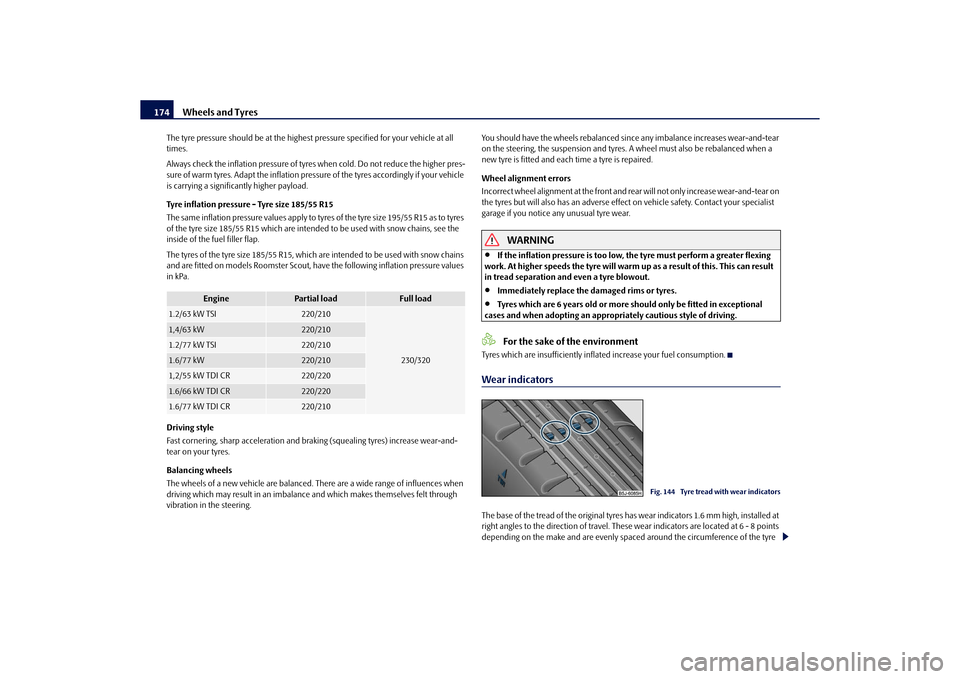
Wheels and Tyres
174
The tyre pressure should be at the highest pressure specified for your vehicle at all
times.
Always check the inflation pressure of tyres when cold. Do not reduce the higher pres-
sure of warm tyres. Adapt the inflation pressure of the tyres accordingly if your vehicle
is carrying a significantly higher payload.
Tyre inflation pressure - Tyre size 185/55 R15
The same inflation pressure values apply to ty res of the tyre size 195/55 R15 as to tyres
of the tyre size 185/55 R15 which are intended to be used with snow chains, see the
inside of the fuel filler flap.
The tyres of the tyre size 185/55 R15, which are intended to be used with snow chains
and are fitted on models Roomster Scout, have the following inflation pressure values
in kPa.
Driving style
Fast cornering, sharp acceleration and brak ing (squealing tyres) increase wear-and-
tear on your tyres.
Balancing wheels
The wheels of a new vehicle are balanced. There are a wide range of influences when
driving which may result in an imbalance and which makes themselves felt through
vibration in the steering. You should have the wheels rebalanced si
nce any imbalance increases wear-and-tear
on the steering, the suspension and tyres. A wheel must also be rebalanced when a
new tyre is fitted and each time a tyre is repaired.
Wheel alignment errors
Incorrect wheel alignment at the front and rear will not only increase wear-and-tear on
the tyres but will also has an adverse effect on vehicle safety. Contact your specialist
garage if you notice any unusual tyre wear.
WARNING
If the inflation pressure is too low, the tyre must perform a greater flexing
work. At higher speeds the tyre will warm up as a result of this. This can result
in tread separation and even a tyre blowout.
Immediately replace the damaged rims or tyres.
Tyres which are 6 years old or more should only be fitted in exceptional
cases and when adopting an appropriately cautious style of driving.For the sake of the environment
Tyres which are insufficiently inflated increase your fuel consumption.Wear indicatorsThe base of the tread of the original tyres has wear indicators 1.6 mm high, installed at
right angles to the direction of travel. These wear indicators are located at 6 - 8 points
depending on the make and are evenly spaced around the circumference of the tyre
Engine
Partial load
Full load
1.2/63 kW TSI
220/210
230/320
1,4/63 kW
220/210
1.2/77 kW TSI
220/210
1.6/77 kW
220/210
1,2/55 kW TDI CR
220/220
1.6/66 kW TDI CR
220/220
1.6/77 kW TDI CR
220/210
Fig. 144 Tyre tread with wear indicators
s16g.4.book Page 174 Wednesda y, February 10, 2010 3:53 PM
Page 176 of 231

Wheels and Tyres175
Using the system
Safety
Driving Tips
General Maintenance
Breakdown assistance
Praktik
Technical Data
fig. 144 . Markings on the walls of the tyres through the letters “TWI”, triangular
symbols or other symbols identify the position of the wear indicators.
A remaining tread of just 1.6 mm, measured in the grooves of the tread next to the wear
indicators, means that your tyres have reached their legally permissible minimum
tread depth.
WARNING
You must have your tyres replaced with new ones at the latest when the
wear indicators have been worn down . The legally permissible minimum tread
depth should be observed.
Worn tyres do not provide the necessary adhesion to the road surface at
high speeds on wet roads. One could e xperience “aquaplaning” (uncontrolled
movements of the vehicle - “swimming” on a wet road surface).
Changing wheels aroundIf significantly greater wear is present on the front tyres, we recommend changing the
front wheels around with the rear wheels. You will then obtain approximately the same
life for all the tyres.
It may be advantageous to swap the tyres ov er “crosswise” when certain types of wear
characteristic arise on the running surface of the tyres (but not in the case of unidirec-
tional tyres). Specialist garages are familiar with details.
We recommend that you change the wheels around every 10 000 km in order to
achieve even wear on all wheels and to obtain optimal tyre life.New tyres and wheelsTyres and wheel rims are important design elements. One should therefore use the
tyres and wheel rims which have been releas ed for use by Škoda Auto. They are exactly
matched to the vehicle type and therefore contribute significantly to good road
holding and safe driving characteristics .
Only fit radial tyres of the same type on all 4 wheels, size (rolling circumference) and, if
possible, the same tread pattern on one axle. The specialist garage has access to the most current information about which tyres we
have released for us
e on your vehicle.
We recommend that you have any work relati ng to tyres or wheels carried out by a
specialist garage . Your dealer has all of the necessary special tools and replacement
parts available plus the required specialist knowledge and is also in a position to prop-
erly dispose of the old tyres. A large number of specialist garages also have an attrac-
tive range of tyres and wheels available.
The tyre/wheel combinations which are appr oved for your vehicle are indicated in
your vehicle documents. Approval and licensing may differ according to the legislation
prevailing in individual countries.
Proper knowledge of the tyre data makes it easier for you to select the correct type of
tyre. Tyres do, for example, have the following inscription on their walls:
185 / 65 R 14 86 T
What this means is:
The following speed restrictions apply to tyres.
185
Tyre wi dt h i n mm
65
Height/width ratio in %
R
Code letter for the type of tyre - R adial
14
Diameter of wheel in inches
86
Load index
T
Speed symbol
Speed symbol
Permissible maximum speed
Q
160 km/h
R
170 km/h
S
180 km/h
T
190 km/h
U
200 km/h
s16g.4.book Page 175 Wednesda y, February 10, 2010 3:53 PM
Page 177 of 231
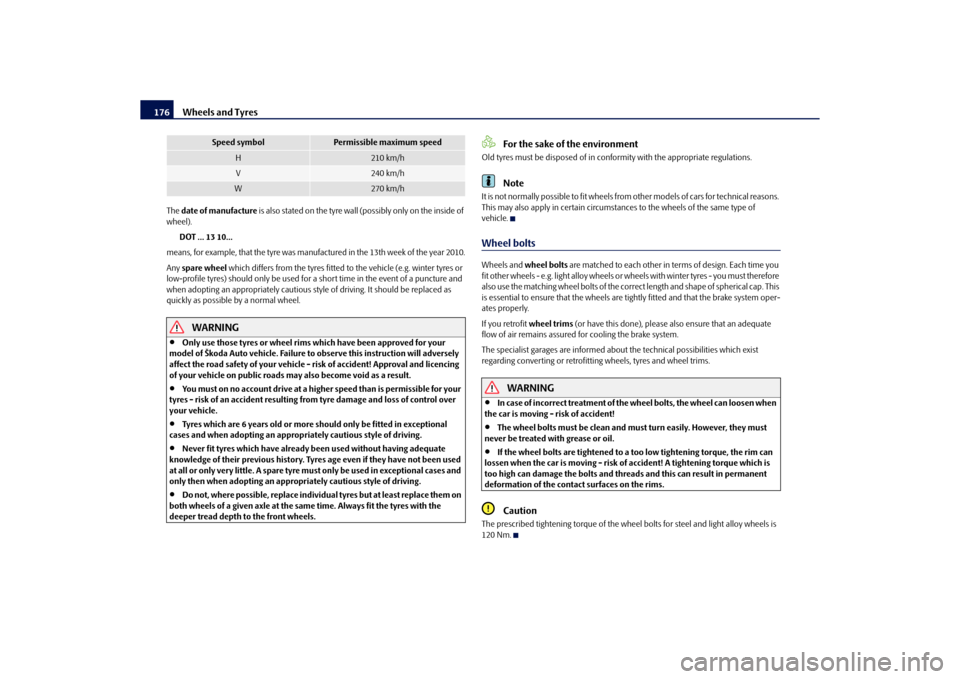
Wheels and Tyres
176
The date of manufacture is also stated on the tyre wall (possibly only on the inside of
wheel).
DOT ... 13 10...
means, for example, that the tyre was ma nufactured in the 13th week of the year 2010.
Any spare wheel which differs from the tyres fitted to the vehicle (e.g. winter tyres or
low-profile tyres) should only be used for a short time in the event of a puncture and
when adopting an appropriately cautious styl e of driving. It should be replaced as
quickly as possible by a normal wheel.
WARNING
Only use those tyres or wheel rims which have been approved for your
model of Škoda Auto vehicle. Failure to observe this instruction will adversely
affect the road safety of your vehicle - risk of accident! Approval and licencing
of your vehicle on public roads ma y also become void as a result.
You must on no account drive at a high er speed than is permissible for your
tyres - risk of an accident resulting from tyre damage and loss of control over
your vehicle.
Tyres which are 6 years old or more should only be fitted in exceptional
cases and when adopting an approp riately cautious style of driving.
Never fit tyres which have already been used without having adequate
knowledge of their previous history. Tyre s age even if they have not been used
at all or only very little. A spare tyre must only be used in exceptional cases and
only then when adopting an appropriately cautious style of driving.
Do not, where possible, replace individu al tyres but at least replace them on
both wheels of a given axle at the same time. Always fit the tyres with the
deeper tread depth to the front wheels.
For the sake of the environment
Old tyres must be disposed of in conformity with the appropriate regulations.
Note
It is not normally possible to fit wheels from other models of cars for technical reasons.
This may also apply in certain circumstance s to the wheels of the same type of
vehicle.Wheel boltsWheels and wheel bolts are matched to each other in terms of design. Each time you
fit other wheels - e.g. light alloy wheels or wheels with winter tyres - you must therefore
also use the matching wheel bolts of the corr ect length and shape of spherical cap. This
is essential to ensure that the wheels are tightly fitted and that the brake system oper-
ates properly.
If you retrofit wheel trims (or have this done), please also ensure that an adequate
flow of air remains assured for cooling the brake system.
The specialist garages are informed about the technical possibilities which exist
regarding converting or retrofitting wheels, tyres and wheel trims.
WARNING
In case of incorrect treatment of the wheel bolts, the wheel can loosen when
the car is moving - risk of accident!
The wheel bolts must be clean and must turn easily. However, they must
never be treated with grease or oil.
If the wheel bolts are tightened to a too low tightening torque, the rim can
lossen when the car is moving - risk of accident! A tightening torque which is
too high can damage the bolts and threads and this can result in permanent
deformation of the contact surfaces on the rims.Caution
The prescribed tightening torque of the wheel bolts for steel and light alloy wheels is
120 Nm.
H
210 km/h
V
240 km/h
W
270 km/h
Speed symbol
Permissible maximum speed
s16g.4.book Page 176 Wednesda y, February 10, 2010 3:53 PM
Page 178 of 231
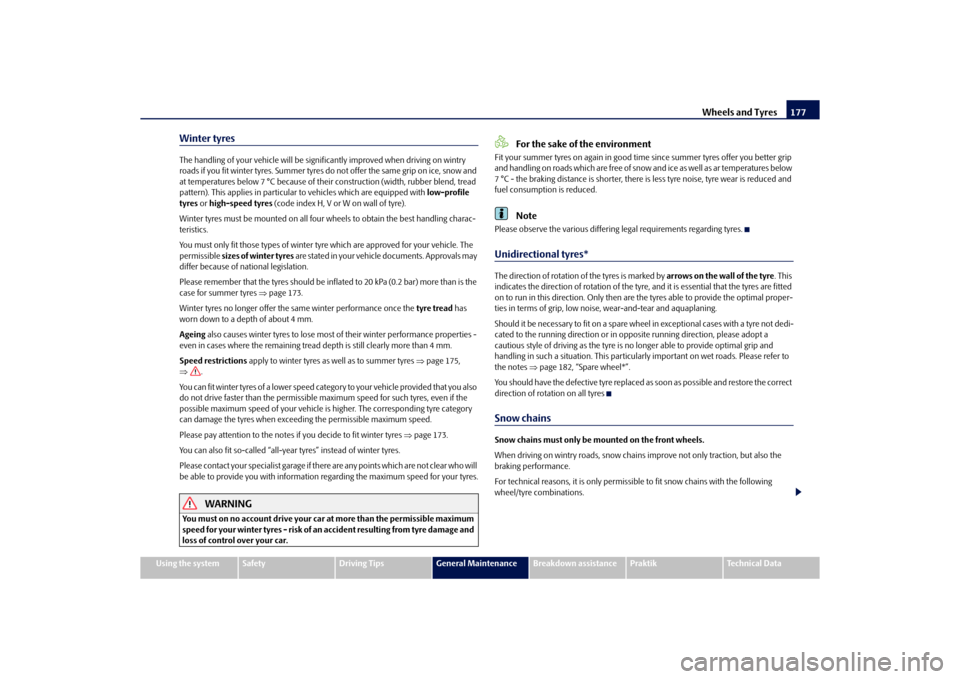
Wheels and Tyres177
Using the system
Safety
Driving Tips
General Maintenance
Breakdown assistance
Praktik
Technical Data
Winter tyresThe handling of your vehicle will be signif icantly improved when driving on wintry
roads if you fit winter tyres. Summer tyres do not offer the same grip on ice, snow and
at temperatures below 7 °C because of thei r construction (width, rubber blend, tread
pattern). This applies in particular to vehicles which are equipped with low-profile
tyres or high-speed tyres (code index H, V or W on wall of tyre).
Winter tyres must be mounted on all four wheels to obtain the best handling charac-
teristics.
You must only fit those types of winter tyre which are approved for your vehicle. The
permissible sizes of winter tyres are stated in your vehicle documents. Approvals may
differ because of na tional legislation.
Please remember that the tyres should be inflated to 20 kPa (0.2 bar) more than is the
case for summer tyres page 173.
Winter tyres no longer offer the same winter performance once the tyre tread has
worn down to a depth of about 4 mm.
Ageing also causes winter tyres to lose most of their winter performance properties -
even in cases where the remaining tread depth is still clearly more than 4 mm.
Speed restrictions apply to winter tyres as well as to summer tyres page 175,
.
You can fit winter tyres of a lower speed catego ry to your vehicle provided that you also
do not drive faster than the permissible maximum speed for such tyres, even if the
possible maximum speed of your vehicle is higher. The corresponding tyre category
can damage the tyres when exceeding the permissible maximum speed.
Please pay attention to the notes if you decide to fit winter tyres page 173.
You can also fit so-called “all-year tyres” instead of winter tyres.
Please contact your specialist garage if there are any points which are not clear who will
be able to provide you with information regarding the maximum speed for your tyres.
WARNING
You must on no account drive your car at more than the permissible maximum
speed for your winter tyres - risk of an accident resulting from tyre damage and
loss of control over your car.
For the sake of the environment
Fit your summer tyres on again in good time since summer tyres offer you better grip
and handling on roads which are free of snow and ice as well as ar temperatures below
7 °C - the braking distance is shorter, there is less tyre noise, tyre wear is reduced and
fuel consumption is reduced.
Note
Please observe the various differing legal requirements regarding tyres.Unidirectional tyres*The direction of rotation of the tyres is marked by arrows on the wall of the tyre. This
indicates the direction of rotation of the tyre, and it is essential that the tyres are fitted
on to run in this direction. Only then are the tyres able to provide the optimal proper-
ties in terms of grip, low nois e, wear-and-tear and aquaplaning.
Should it be necessary to fit on a spare wheel in exceptional cases with a tyre not dedi-
cated to the running direction or in oppo site running direction, please adopt a
cautious style of driving as the tyre is no longer able to provide optimal grip and
handling in such a situation. This particular ly important on wet roads. Please refer to
the notes page 182, “Spare wheel*”.
You should have the defective tyre replaced as soon as possible and restore the correct
direction of rotation on all tyresSnow chainsSnow chains must only be mounted on the front wheels.
When driving on wintry roads, snow chains improve not only traction, but also the
braking performance.
For technical reasons, it is only permissible to fit snow chains with the following
wheel/tyre combinations.
s16g.4.book Page 177 Wednesda y, February 10, 2010 3:53 PM
Page 179 of 231
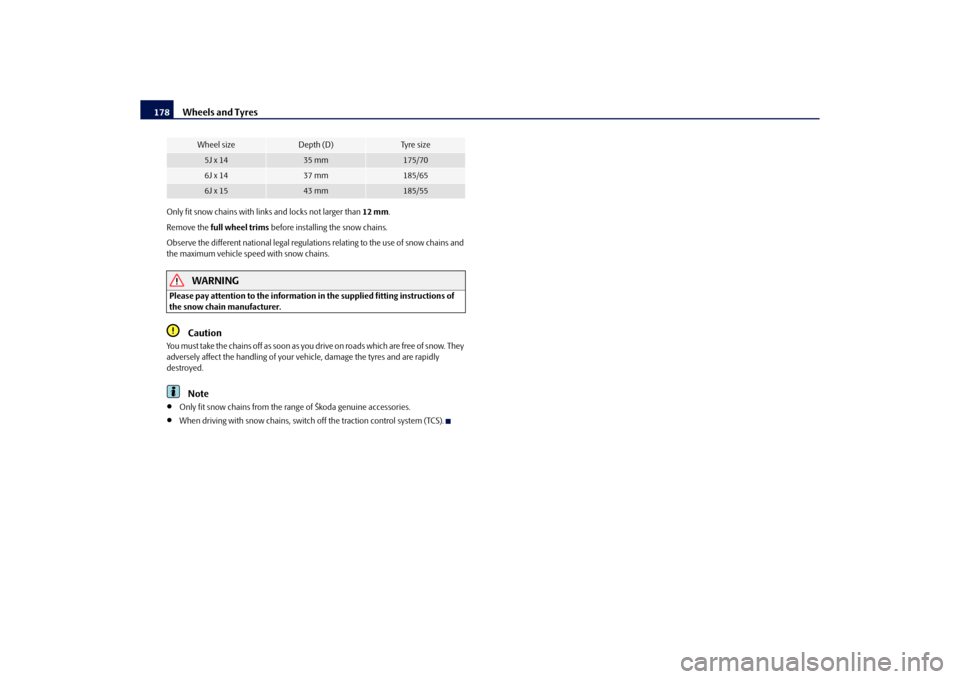
Wheels and Tyres
178
Only fit snow chains with links and locks not larger than 12 mm.
Remove the full wheel trims before installing the snow chains.
Observe the different national legal regulation s relating to the use of snow chains and
the maximum vehicle spee d with snow chains.
WARNING
Please pay attention to the information in the supplied fitting instructions of
the snow chain manufacturer.
Caution
You must take the chains off as soon as you drive on roads which are free of snow. They
adversely affect the handling of your ve hicle, damage the tyres and are rapidly
destroyed.
Note
Only fit snow chains from the ra nge of Škoda genuine accessories.
When driving with snow chains, switch off the traction control system (TCS).
Wheel size
Depth (D)
Ty re s i z e
5J x 14
35 mm
175/70
6J x 14
37 mm
185/65
6J x 15
43 mm
185/55
s16g.4.book Page 178 Wednesda y, February 10, 2010 3:53 PM
Page 180 of 231
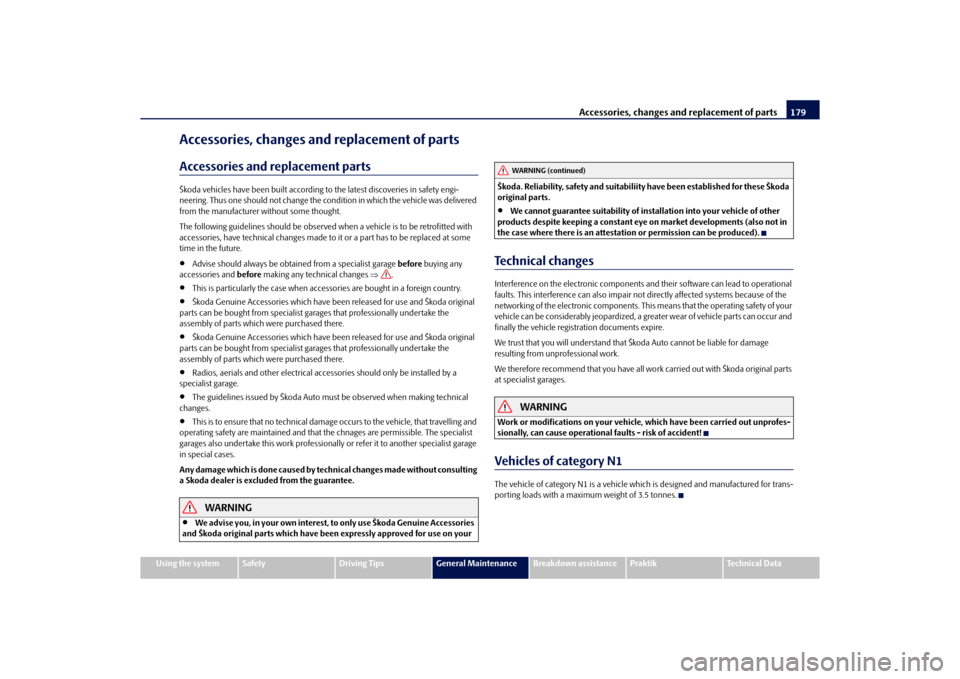
Accessories, changes and replacement of parts179
Using the system
Safety
Driving Tips
General Maintenance
Breakdown assistance
Praktik
Technical Data
Accessories, changes and replacement of partsAccessories and replacement partsŠkoda vehicles have been built according to the latest discoveries in safety engi-
neering. Thus one should not change the co ndition in which the vehicle was delivered
from the manufacturer without some thought.
The following guidelines should be observed when a vehicle is to be retrofitted with
accessories, have technical ch anges made to it or a part has to be replaced at some
time in the future.
Advise should always be obtained from a specialist garage before buying any
accessories and before making any technical changes .
This is particularly the case when acce ssories are bought in a foreign country.
Škoda Genuine Accessories which have been released for use and Škoda original
parts can be bought from specialist garages that professionally undertake the
assembly of parts which were purchased there.
Škoda Genuine Accessories wh ich have been released for use and Škoda original
parts can be bought from specialist garages that professionally undertake the
assembly of parts which were purchased there.
Radios, aerials and other electrical acce ssories should only be installed by a
specialist garage.
The guidelines issued by Škoda Auto mu st be observed when making technical
changes.
This is to ensure that no technical damage occurs to the vehicle, that travelling and
operating safety are maintained and that the chnages are permissible. The specialist
garages also undertake this work professionally or refer it to another specialist garage
in special cases.
Any damage which is done caused by tech nical changes made without consulting
a Skoda dealer is exclud ed from the guarantee.
WARNING
We advise you, in your own interest, to only use Škoda Genuine Accessories
and Škoda original parts which have been expressly approved for use on your Škoda. Reliability, safety and suitabiliity have been established for these Škoda
original parts.
We cannot guarantee suitability of installation into your vehicle of other
products despite keeping a constant eye on market developments (also not in
the case where there is an attestation or permission can be produced).
Technical changesInterference on the electronic components and their software can lead to operational
faults. This interference can also impair no t directly affected systems because of the
networking of the electronic components. This means that the operating safety of your
vehicle can be considerably je opardized, a greater wear of vehicle parts can occur and
finally the vehicle regist ration documents expire.
We trust that you will understand that Šk oda Auto cannot be liable for damage
resulting from unprofessional work.
We therefore recommend that you have all wo rk carried out with Škoda original parts
at specialist garages.
WARNING
Work or modifications on your vehicle, which have been carried out unprofes-
sionally, can cause operational faults - risk of accident!Vehicles of category N1The vehicle of category N1 is a vehicle wh ich is designed and manufactured for trans-
porting loads with a maximum weight of 3.5 tonnes.
WARNING (continued)
s16g.4.book Page 179 Wednesda y, February 10, 2010 3:53 PM